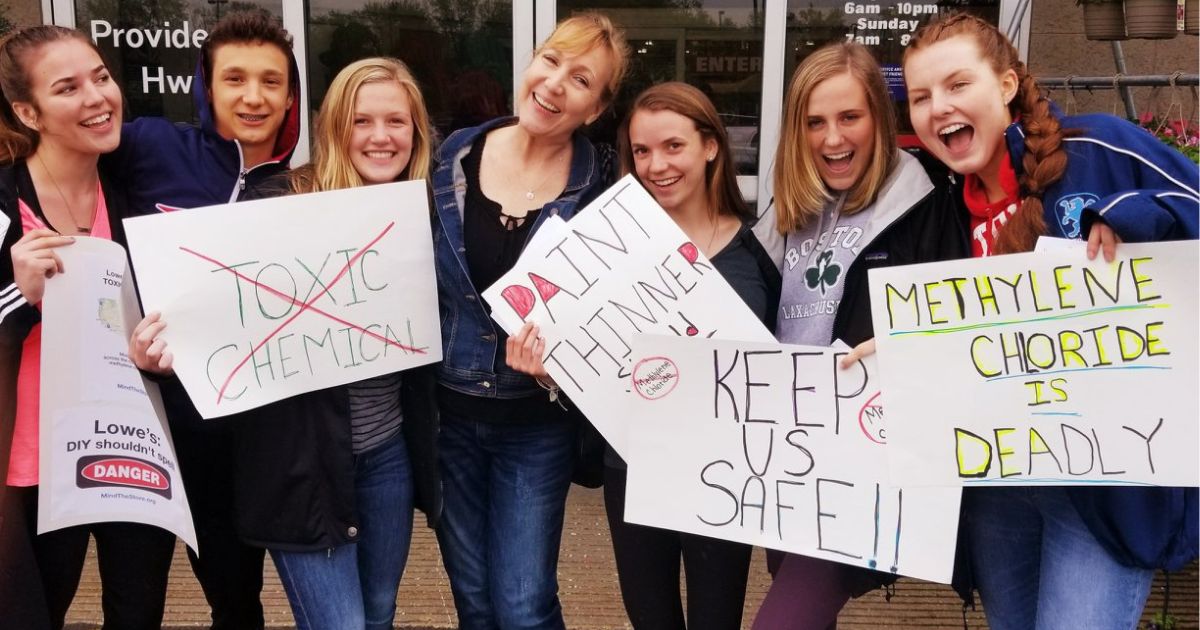We’ve had an exciting development in Toxic-Free Future’s campaign to ban deadly methylene chloride that we should celebrate!
The big news is that the U.S. Environmental Protection Agency used its authority under the Toxic Substances Control Act (TSCA) to finalize a ban on all consumer uses and most commercial uses of this toxic chemical in all products including spot removers, degreasers, adhesives, and sealants. This was only the second final “risk management rule” under the 2016 TSCA amendments.
This victory has been a long time coming.
We’ve come a long way from the days when anyone with a DIY project could go to the hardware store and buy paint strippers with methylene chloride. Now, methylene chloride is banned not only in paint strippers, but in all consumer and most industrial uses of this dangerous chemical.
EPA’s final rule will prevent deaths from acute exposures. It will also reduce the serious illnesses like cancers and kidney and liver toxicity that result from long-term exposures. And it will reduce the demand for dangerous petrochemicals. Between 100-500 million pounds of methylene chloride, a solvent made from fossil fuels, are produced annually. This ban is expected to reduce that volume by a third.
If we can ban chemicals made from fossil fuels and show public and government support, we will be better able to break the petrochemical industry’s deadly grip on our economy and speed the transition to safer chemicals and materials.
We are proud of the work that our staff and volunteers, activists, partners, and allies did to make this happen. As we have said for years – methylene chloride has no place in our homes or workplaces. It’s worth looking back at all the work that got us to this point.
We used a combination of policy, market, and legal strategies to win.
Toxic-Free Future aggressively worked for this national ban, strategically aligning our federal policy and marketplace transformation programs. We pursued litigation to protect workers and communities. We worked with the team of research scientists at USCF who have long studied the effects of exposure to this deadly chemical.
Our seven-year national campaign focused on tragic deaths from methylene chloride exposure. Methylene chloride, also known as dichloromethane or DCM, was among the first chemicals EPA targeted for review and regulation under the 2016 TSCA reforms. Separately, Obama EPA Administrator Gina McCarthy proposed a ban on paint strippers and coating removers containing DCM in early 2017, which the Trump EPA backburnered upon taking office.
Dozens of people who used paint and coating removers with the chemical lost their lives, including Drew Wynne, Kevin Hartley, and Joshua Atkins, who died from acute exposures in 2017 and 2018. Their families were absolutely heroic — unimaginable grief fueled their unrelenting advocacy to get this ban across the finish line.
As part of our integrated strategy to ban these dangerous chemicals, we led a market campaign to eliminate paint strippers with DCM at more than 30,000 stores across North America and around the world. Over the span of two years, we secured commitments from more than a dozen major retailers including Lowe’s, The Home Depot, Walmart, Amazon.com, and others to stop selling such products.
Key to moving Lowe’s was a heartbreaking petition featuring Drew Wynne’s parents. Drew died in 2017 refinishing the floor of his coffee business with a paint stripper he purchased from Lowe’s. The petition garnered more than 200,000 signers. We also worked with coalition partners from across the country like Defend Our Health, Clean Water Action, and Ecology Center to organize other campaign activities outside stores in more than a dozen states to get the attention of the C-suite executives at retailers.
To show that safer solutions were available, we worked with the Toxic Use Reduction Institute (TURI) to identify, evaluate, and create lists of safer alternatives already available in stores (along with regrettable substitutes to avoid), which we shared in our communications with retailers and decision-makers.
Despite thousands of public comments in its favor, the Trump EPA shelved the 2017 proposal to ban paint strippers containing DCM. But that didn’t stop us or the families we worked with! In 2019, we were able to win a ban on consumer sales. Because commercial uses continued, leaving workers unprotected, we joined with Kevin Hartley’s and Joshua Atkins’s moms, partner organizations including Labor Council for Latin American Advancement, NRDC, Vermont PIRG, and Earthjustice to challenge the EPA’s failure to protect workers and communities.
We also worked with partners at UC San Francisco’s Program on Reproductive Health and the Environment (PRHE) to promote their peer-reviewed research documenting 85 deaths related to DCM exposures between 1980-2018.
The Biden EPA concluded its evaluation of methylene chloride and proposed a more comprehensive ban! In the 2022 revised final evaluation, the EPA determined that methylene chloride posed an “unreasonable risk” to public health and the environment. In April 2023, EPA finally proposed bans on all consumer uses and most commercial and industrial uses.
Over the last year, Toxic-Free Future continued our advocacy with EPA and the White House and mobilized thousands of people from across the country to join us in comments urging EPA to completely ban methylene chloride and protect as many people as possible.
Success! At last, a ban on methylene chloride
On April 30, 2024, the EPA announced a final ban on all consumer uses of methylene chloride and most commercial and industrial uses. This victory took a long time to win, but thanks to the courage of the families and the hard work and persistence of so many for so long, we did it!
While the final rule allows continued use in too many workplaces, this is one of the most sweeping actions the EPA has ever taken under TSCA and will prevent exposures that lead to devastating illness and death in our homes and workplaces.
As we celebrate, we’ll keep working toward more action to protect us all from toxic chemicals.





